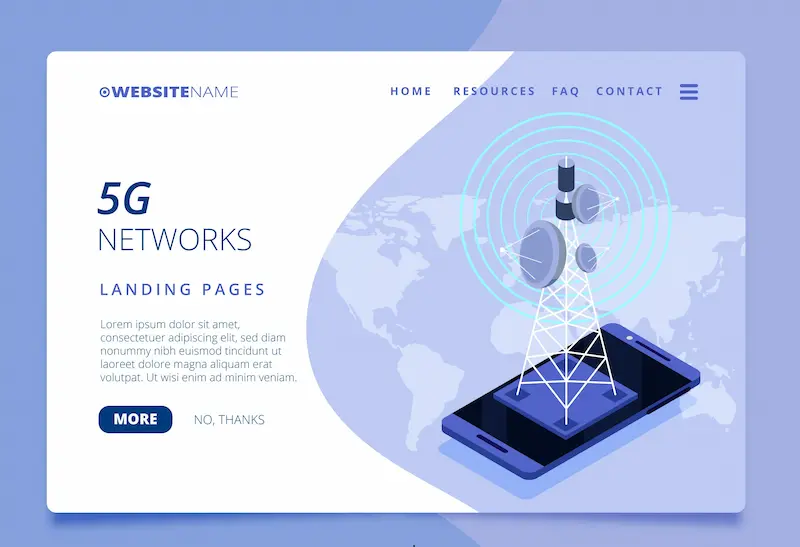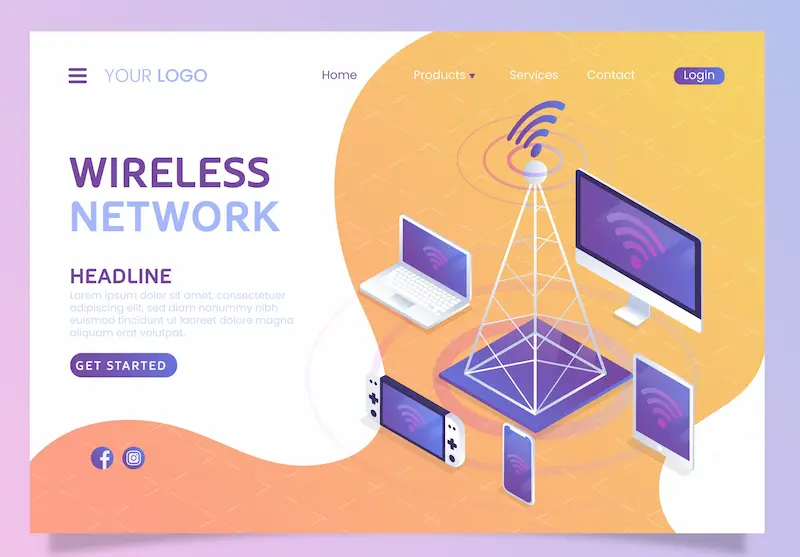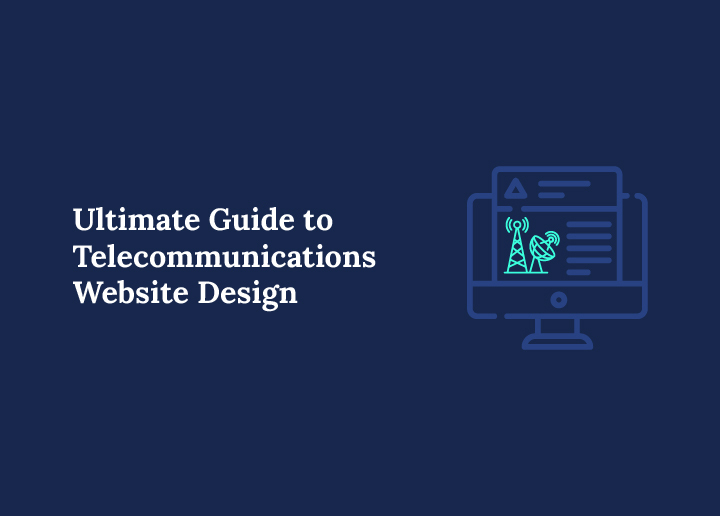The telecommunications industry stands at the forefront of innovation, connecting the world through intricate networks and groundbreaking services. In this rapidly evolving landscape, telecommunications website design plays a pivotal role; it’s no longer just an afterthought but the central hub for customer engagement, service delivery, and brand identity.
A well-designed telecommunications website can be a powerful digital storefront, a comprehensive support center, and a dynamic marketing tool. This guide provides essential components for creating a professional and high-performing telecommunications website.
Whether you are a telecom executive, marketer, web developer, or an enthusiast, you will learn key principles, essential features, user experience best practices, and effective SEO strategies to establish a strong online presence. We simplify technical aspects and explain complex concepts clearly, equipping you to build a website that engages your audience.
Why Your Telecommunications Website is Your Most Powerful Asset
In today’s digital-first world, your telecommunications website transcends being merely an online brochure. It is the core of your digital strategy, a multi-faceted platform that drives growth, fosters loyalty, and defines your brand in a competitive market. Understanding its pivotal role is the first step toward leveraging its full potential.

Your 24/7 Customer Service Hub
Imagine a customer with a billing question or a technical issue. They can visit your website instead of waiting for business hours to call a helpline. A well-structured telecommunications website offers a robust self-service portal, providing instant access to FAQs, troubleshooting guides, and account management tools.
This round-the-clock availability significantly enhances customer satisfaction. It reduces the burden on your support staff, allowing them to focus on more complex inquiries. From checking data usage to upgrading a plan, your website empowers customers to manage their services efficiently and on their terms. This level of accessibility is a key differentiator in the fast-paced telecom industry.
Ready to Elevate Your Telecom & Networking Brand Online?
Transform your digital presence with our custom Telecommunications and Networking Website Design and Development services.
A Powerful Lead Generation & Sales Platform
Your website is a dynamic sales engine that constantly works to attract new customers and drive conversions. It is the primary gateway for potential clients to explore your offerings, compare plans, and make informed decisions. Effective telecommunications website design integrates clear calls-to-action (CTAs) that guide visitors through the sales funnel.
The website facilitates critical transactions, such as signing up for a new internet package, purchasing a mobile device, or requesting a personalized quote for enterprise solutions. This streamlined approach directly translates into increased sales and market share.
Building Brand Authority & Trust
Your website is your most prominent brand ambassador in an industry where trust and reliability are paramount. A professionally designed, intuitive, and secure site immediately establishes credibility. It showcases your expertise, innovation, commitment, and customer satisfaction.

High-quality visuals, consistent branding, and well-articulated content reinforce your company’s values and mission. When visitors encounter a well-structured and easy-to-navigate telecommunications website, they perceive your brand as reputable and dependable.
Fostering Customer Retention and Loyalty
Beyond attracting new clients, a superior website experience plays a critical role in retaining existing ones. Customers’ satisfaction levels rise when they find it easy to manage their accounts, access support, and discover new services. This ease of interaction builds loyalty and reduces churn.
A dedicated customer portal, personalized recommendations, and proactive service updates available on the website contribute significantly to a positive ongoing relationship. By making the online experience seamless and rewarding, your telecommunications website becomes an indispensable tool for long-term customer engagement and retention.
The Inevitable Impact of Poor Design
Conversely, a poorly designed telecommunications website can severely damage your business. Slow loading times, confusing navigation, outdated information, or a non-responsive layout lead to frustration. Frustrated visitors quickly abandon such sites, resulting in high bounce rates. This poor user experience directly translates into lost sales opportunities and a tarnished brand image.
In the digital age, a website’s performance is often seen as a reflection of a company’s overall quality and reliability. Therefore, investing in top-tier telecommunications website design is not merely an option but a necessity for sustained success.
Learn More: Poor Web Design and What It’s Costing You
Core Principles of Effective Telecommunications Website Design
Building a high-performing telecommunications website requires adherence to fundamental design principles. These principles ensure your site is visually appealing, highly functional, user-friendly, and optimized for business objectives. Mastering these core concepts is crucial for any successful online presence in the telecom sector.
User-Centric Design (UX is King)
User-centric design is about creating intuitive experiences tailored to your audience’s expectations. A good telecom website should smoothly and efficiently guide users from landing to action.

- Detailed User Personas: Define ideal users by demographics, goals, and digital behaviors.
- Journey Mapping: Outline steps users take from discovery to conversion or support.
- Simplified Interfaces: Break down telecom jargon into everyday language.
- Accessible Features: Include assistive tools for users with disabilities.
- Consistent Navigation: Provide intuitive menus and pathways across all pages.
Simplicity & Clarity
Clarity in design helps users locate information without friction. Minimalism in layout, structure, and content keeps the focus where it matters most.
- Minimal Clutter: Use white space and limit on-screen distractions.
- Purposeful CTAs: Prominently display clear, action-oriented buttons.
- Logical Layouts: Organize content with a natural top-down hierarchy.
- Short Paragraphs: Break text into digestible chunks for readability.
- Service Segmentation: Group plans, features, and support for easy access.
Visual Hierarchy & Aesthetics
Effective visual hierarchy guides users’ attention toward key elements and actions. Aesthetic choices should enhance brand identity while supporting usability.

- Contrasting Elements: Use color and size to highlight CTAs or plans.
- Legible Typography: Choose mobile-friendly fonts like Roboto or Open Sans.
- Consistent Branding: Apply a cohesive color palette and design language.
- High-Quality Media: Use clean icons, videos, and infographics to explain services.
- Whitespace Strategy: Space elements to reduce cognitive overload.
Consistency
Consistency enhances user trust and reduces confusion. It reinforces your brand’s professionalism and reliability across every user interaction.
- Unified Style Guide: Apply the same fonts, button styles, and UI elements throughout.
- Predictable UX Patterns: Ensure all elements behave as users expect.
- Aligned Messaging: Maintain the same tone and terminology across content.
- Coherent Layouts: Match the visual structure across all pages.
- Brand Reinforcement: Keep logos, taglines, and icons uniform sitewide.
Mobile Responsiveness (Mobile-First Approach)
With mobile usage surpassing desktop, responsive design must be a priority. Google also ranks mobile versions first, making this essential for SEO and usability.
- Flexible Layouts: Use fluid grids and responsive breakpoints.
- Thumb-Friendly Design: Make buttons easy to tap without zooming.
- Device Testing: Test on various screen sizes and orientations.
- Optimized Media: Use scalable images and adaptive video players.
- Streamlined Navigation: Collapse menus and limit scrolling depth.
Further Reading: Mobile First Design
Fast Load Times & Performance Optimization
Speed directly affects both user satisfaction and SEO performance. A fast-loading website keeps users engaged and improves conversions.
- Compressed Media: Use tools to shrink image and video sizes.
- Optimized Code: Minify CSS, HTML, and JavaScript files.
- Caching Setup: Implement browser and server-side caching mechanisms.
- CDN Integration: Distribute content globally via Content Delivery Networks.
- Core Web Vitals: Monitor metrics like LCP, FID, and CLS for UX health.
Content-First Approach
Content should dictate design, not the other way around. Focus first on what the user needs to read or do, then wrap the design around it.
- Purpose-Driven Pages: Write content that solves real user problems.
- Strategic Layouts: Design with the message, not visuals, in mind.
- Contextual Elements: Support content with relevant imagery or CTAs.
- Scannable Formats: Use bullets, subheadings, and bold text.
- User Flow Mapping: Align content with key customer journey stages.
Also Read: Content Strategy for WordPress Websites
Security & Trust
Trust is vital when users share sensitive data like payment details or personal information. Your website must clearly show that it prioritizes safety.

- Proactive Monitoring: Regularly conduct audits and patch vulnerabilities.
- SSL Encryption: Secure all data transfer with HTTPS.
- MFA Options: Enable multi-factor authentication for user logins.
- Data Compliance: Adhere to GDPR, CCPA, or other relevant regulations.
- Secure Gateways: Integrate trusted payment processing solutions.
By diligently applying these core principles, telecommunications companies can build aesthetically pleasing websites that are highly functional, secure, and effective in achieving their business objectives.
Also Read: Embracing Change to Stay Ahead in Web Design
Essential Features and Functionalities for Telecommunications Websites
Beyond the fundamental design principles, specific features and functionalities are critical for a telecommunications website to serve its diverse user base effectively. These elements enable seamless customer interactions, efficient service delivery, and robust business operations.
Intuitive Navigation & Information Architecture
A well-structured navigation system is the backbone of any effective website, especially for telecom companies with a wide range of services. Users must effortlessly find what they seek.
Main navigation should be straightforward, categorizing services (e.g., “Internet,” “Mobile,” “TV,” “Bundles,” “Business Solutions”), support, and company information. Organize plans, devices, and support articles into easily understandable categories and subcategories. Avoid jargon that might confuse new users.
A prominent search bar lets users quickly find specific information, plans, or support articles. Implement auto-suggestions and filtering options for an enhanced experience. Provide breadcrumb navigation to show users their location within the site hierarchy, aiding navigation and context.
Comprehensive Service & Plan Displays
Your offerings shine here. How you present your plans and services directly impacts customer understanding and conversion rates.
Each service (e.g., fiber internet, 5G mobile plans, landline services) should have dedicated pages with comprehensive details. This includes speeds, data limits, pricing tiers, included features, and any applicable terms and conditions. Allow users to compare different plans side-by-side. This empowers them to make informed decisions based on their needs and budget.
Implement filters (e.g., by speed, price, data) to narrow options. Consider AI-driven personalized recommendations based on user browsing history or declared preferences. Display all costs, including setup fees, taxes, and contract lengths. Hidden fees erode trust and lead to customer dissatisfaction.
Know About: Web Design Packages
User Account Management & Self-Service Portal
Empowering customers with self-service options reduces support calls and enhances satisfaction. A dedicated portal is a cornerstone of modern telecommunications website design.
A straightforward registration and login process is crucial, possibly integrating with social media accounts or existing identifiers. Users should be able to update personal information, contact preferences, and communication settings. Customers should also be able to view their bills, track usage, make payments, set up auto-pay, and access payment history securely.
Provide precise, real-time data usage meters for mobile and internet plans. If applicable, allow users to upgrade, downgrade, or change their service plans directly from their portal. A robust knowledge base with answers to frequently asked questions and step-by-step troubleshooting guides for common issues is invaluable.
Customer Support & Communication Channels
Accessibility to support is crucial for a positive customer experience. Offer multiple channels to cater to diverse preferences. Make your phone numbers, email addresses, and physical locations (if applicable) easily findable. Integrate a live chat feature for real-time assistance, which is often preferred for quick queries.

Implement AI-powered chatbots for instant answers to common questions, guiding users to relevant information, or escalating complex issues to human agents. This reduces wait times and improves efficiency.
For more complex issues, provide a system where users can submit tickets and track their resolution status. Link to your official social media profiles where customers can seek support or stay updated.
Online Ordering & Activation
The website is the primary sales channel for many telecom companies’ new subscriptions and devices. A straightforward, multi-step process for new service activations or plan upgrades minimizes friction and drop-offs.
If you sell devices (phones, modems, smart home gadgets), integrate a secure e-commerce platform with product catalogs, shopping carts, and secure checkout. Customers can track the status of their new service activation or device delivery.
Engaging Content Sections
Content fuels engagement, educates customers, and boosts your SEO. A regularly updated blog section for industry news, technology explanations (e.g., “What is Fiber Internet?”), How-to guides and company updates are essential. Use videos to explain complex services, showcase product demos, or feature customer testimonials.
Highlight positive customer experiences and successful business solutions to build social proof and trust. Provide in-depth articles on emerging technologies like 5G, IoT, smart home solutions, and cybersecurity relevant to telecommunications.
Lead Generation Forms
Capture potential customer interest and build your marketing database by offering email subscriptions for new plans, promotions, or industry news updates.

Provide simple forms for general inquiries or specific service requests. These forms should be easy to find and fill out, encouraging user engagement.
Analytics Integration
Understanding how users interact with your telecommunications website is crucial for continuous improvement and strategic decision-making. Analytics tools provide invaluable insights.
Integrate powerful analytics platforms like Google Analytics. These tools allow you to track key metrics such as website traffic, user behavior, bounce rates, conversion paths, and demographic information.
By monitoring these data points, you can identify areas for improvement in your telecommunications website design, content, and user experience. Regular analysis helps you refine your digital strategy and achieve better business outcomes.
Read More: How to Add Google Analytics to Your WordPress Site
SEO Strategies for Telecommunications Websites
Search Engine Optimization (SEO) is not an afterthought but an integral part of telecommunications website design. A visually stunning site does little good if potential customers cannot find it. Implementing robust SEO strategies ensures your website ranks high in search results, attracting organic traffic and qualified leads.
Keyword Research (Telecom-Specific)
Effective SEO begins with understanding what your target audience searches for. This involves meticulous keyword research tailored to the telecommunications industry.
Key actions include:
- Identify primary keywords such as “5G plans,” “fiber optic internet,” “broadband deals,” or “mobile network providers.”
- Research long-tail keywords like “unlimited data plan for families” or “high-speed internet for small businesses in [city name].”
- Target location-specific keywords if you offer regional services, such as “[city] internet provider.”
- Use keyword research tools like Google Keyword Planner or Ahrefs to analyze search volume and competition.
On-Page SEO Optimization
On-page SEO involves optimizing individual web pages to rank higher and earn more relevant traffic in search engines. It is crucial for how users and search engines interact with your site.
Best practices include:
- Craft keyword-rich and compelling title tags and meta descriptions.
- Structure your content using clear heading tags (H1, H2, H3).
- Create high-quality, value-driven content that answers user queries.
- Optimize images with compression and descriptive alt text.
- Use internal links to guide visitors and distribute link equity.
Explore Further: A Comprehensive Guide To On-Page Vs Off-Page SEO
Technical SEO
Technical SEO focuses on website and server optimizations that help search engine crawlers crawl and index your site effectively. A well-optimized backend is just as important as a polished frontend.

Recommendations:
- Prioritize fast page load times and optimize for Google’s Core Web Vitals.
- Ensure mobile-friendliness across all devices.
- Implement structured data (Schema.org) for enhanced search listings.
- Maintain a current XML sitemap and a well-structured robots.txt file.
- Fix broken links and eliminate crawl errors using tools like Google Search Console.
Link Building
Link building involves acquiring hyperlinks from other websites that are relevant to your own. These backlinks act as trust signals and significantly influence your SEO rankings.
Key strategies include:
- Develop a strong internal linking structure to enhance user flow and page authority.
- Link to high-authority external sources to add credibility.
- Earn backlinks from industry publications, telecom blogs, and reputable news sites.
- Utilize guest blogging, broken link outreach, and shareable assets like infographics.
- Avoid black-hat link practices, which can lead to penalties.
Content Strategy for SEO
Content is the fuel for your SEO engine. A strategic content plan helps you consistently produce valuable, search-optimized material.
Tactics to implement:
- Regularly update existing posts and publish fresh, relevant content.
- Create pillar content on core topics and develop clusters of interlinked subtopics.
- Focus on addressing customer FAQs, industry trends, and telecom pain points.
- Use a content calendar to ensure consistency and topical variety.
- Monitor performance metrics to refine future content efforts.
The Role of WordPress in Telecommunications Website Design
WordPress often emerges as a top contender when considering the platform for your telecommunications website. Its versatility, robust features, and extensive ecosystem make it an excellent choice for businesses ranging from startups to large enterprises.

Why WordPress?
WordPress powers a significant portion of the internet due to its user-friendliness and powerful capabilities. It offers a flexible and scalable foundation, ideal for managing the complex content and functionalities a telecommunications website requires. You do not need to be a coding expert to manage content and make updates, making it accessible for various team members.
Themes & Plugins
The strength of WordPress lies in its vast array of themes and plugins.
You can choose from thousands of responsive themes to establish a professional and modern aesthetic for your telecommunications website. These themes provide the framework for design while adapting to various devices. Essential plugins enhance functionality, security, and performance.
SEO plugins like Yoast SEO or Rank Math help you optimize your content and technical settings for search engines. Security plugins (e.g., Wordfence) protect your site from threats. Performance plugins (e.g., WP Super Cache, LiteSpeed Cache) ensure fast loading times.
For e-commerce capabilities, WooCommerce seamlessly integrates with WordPress, allowing you to sell devices or subscription plans. Many plugins also exist for customer support, CRM integration, and analytics tracking, further extending your telecom website’s capabilities.
Scalability for Growth
WordPress is highly scalable, meaning your website can grow alongside your telecommunications business. WordPress can handle the increased demands as you expand your service offerings, add new customer segments, or increase your online traffic.
It supports large databases, extensive content libraries, and high user volumes, ensuring that your initial investment in telecommunications website design remains viable for the long term.
Community & Support
WordPress benefits from a massive global community of developers, designers, and users. This extensive community means you can access many resources for troubleshooting, learning, and finding expert assistance.
Online forums, documentation, tutorials, and a marketplace for professional services are readily available. This strong support system ensures you can always find solutions and keep your telecommunications website running smoothly.
Considerations
While WordPress offers numerous advantages, it also comes with considerations. You must commit to proper maintenance, including regular themes, plugins, and core WordPress software updates. Neglecting updates can create security vulnerabilities or compatibility issues.
Custom development might require highly customized functionalities specific to a large telecom operation, potentially requiring experienced WordPress developers. Due to the sensitive nature of customer data, ensuring robust security for a WordPress telecommunications website is paramount. This means regular backups and diligent security practices are not optional.
Advanced Considerations & Future Trends
The telecommunications industry is dynamic, constantly shaped by technological advancements and evolving consumer behaviors. A forward-thinking telecommunications website design must anticipate these changes and incorporate innovative elements to remain competitive and relevant.
AI & Automation in Design
Artificial intelligence (AI) and automation transform how users interact with websites and businesses. Your telecom website can harness these technologies for enhanced user experiences and operational efficiency.

AI-powered chatbots provide instant, 24/7 customer support. They resolve common queries and guide users to relevant information, freeing human agents to handle more complex issues and improving overall service quality.
AI can personalize content and offers based on user behavior, browsing history, and demographics. Imagine a website that suggests the perfect internet plan based on a customer’s typical data usage, or a mobile deal tailored to their device preferences.
Automation can streamline backend processes, from order fulfillment to customer service follow-ups. This leads to faster service delivery and reduced operational costs. AI can also analyze vast user data to provide actionable insights for optimizing website design and marketing strategies.
Voice User Interfaces (VUI)
The rise of voice assistants like Alexa, Google Assistant, and Siri means optimizing your telecommunications website for voice search is increasingly important. Users are now asking questions directly to their devices.
Ensure your content is structured to answer common voice queries directly and concisely. Think about how users verbally ask for “internet plans near me” or “best mobile network in [city].” Optimizing for conversational long-tail keywords will be critical. Your website content should provide clear, factual answers that voice assistants can easily extract and read aloud. This growing channel ensures your telecom services are discoverable.
Immersive Experiences
As technology advances, websites move beyond static pages to offer more engaging, immersive experiences. These can capture user attention and better demonstrate complex telecom products.
Consider incorporating Augmented Reality (AR) or Virtual Reality (VR) elements. For instance, an AR feature could allow customers to visualize how a new modem or smart home device would look in their living room before purchasing it. VR could offer virtual data center tours or explain network infrastructure in an interactive, engaging way.
Such immersive experiences can differentiate your telecommunications website and provide a memorable user journey, helping customers visualize the benefits of your services more vividly.
Edge Computing & IoT Integration
The growth of the Internet of Things (IoT) and edge computing will increasingly impact telecommunications services. Your website must reflect and potentially manage these connected devices and network capabilities.
Your telecommunications website might offer dashboards or management portals for customers’ smart home devices connected via your network.
It could provide information and support for IoT solutions for consumer or business clients. The website can serve as a hub for understanding and interacting with these cutting-edge network capabilities, showcasing your role in the connected future.
Personalization
Personalization goes beyond basic recommendations; it’s about delivering a tailored experience for each user. This makes the telecommunications website more relevant and effective.
Use data to tailor content, promotions, and offers dynamically based on individual user data, past interactions, and stated preferences. For example, a returning customer might see special upgrade offers, while a new visitor might see introductory packages.
This could involve showing different landing pages or modifying product displays based on geographic location or user segment. Personalization improves engagement, increases conversion rates, and builds stronger customer relationships.
Sustainability (Green Web Design)
As environmental concerns grow, so does the demand for sustainable practices in all industries, including telecommunications and web design. “Green web design” focuses on reducing the environmental impact of your website.
This involves choosing eco-friendly hosting providers that use renewable energy. It also means optimizing your website for efficiency to reduce energy consumption during data transmission and display. Strategies include minimizing file sizes, optimizing code, reducing reliance on heavy animations, and using dark mode where appropriate.
A sustainable telecommunications website contributes positively to the environment and enhances your brand’s image as a responsible corporate citizen.
Explore Further: Best WordPress Web Design Agencies
Conclusion
Building an exceptional telecommunications website requires more than good design; it demands strategic thinking, user-focused functionality, and a deep understanding of your market. In such a competitive industry, your website is your brand’s digital foundation and a critical customer acquisition and retention touchpoint.
This guide has outlined key components for success: intuitive UX, mobile responsiveness, robust security, and strong SEO practices. Features like live chat, interactive tools, and clear CTAs elevate the user journey and foster engagement.
Success doesn’t stop at launch; ongoing optimization and adaptation are essential. By staying ahead of digital trends and continuously refining your strategy, your telecommunications website can remain a powerful engine for growth and innovation.



